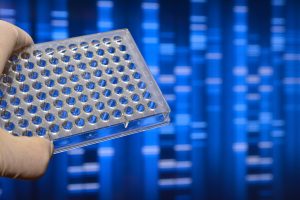16 Fév SARS-CoV-2 Mutations – Cause for Concern? (Revised 1)
SARS-CoV-2 Mutations – Cause for Concern?
The accumulation of genetic mutations is a normal part of viral evolution. Mutations change the sequence of the viral genome, creating different ‘variants.’ While some mutations might be silent, with no visible clinical effect, others might have implications for disease transmission, severity, reinfection potential, and immunity.
SARS-CoV-2 variants
A recently described clinically significant mutation has been termed N501Y, which put simply means that the amino acid ‘N’ at position 501 of the spike protein has been substituted for a ‘Y’. While this may seem innocuous, it in fact causes the virus to behave differently, including how tightly the spike protein binds to the ACE2 receptor – allowing for easier viral entry into human cells and an increase in viral transmission (1-3).
This key mutation has been observed in several SARS-CoV-2 strains, with a widespread geographical presence originating in the United Kingdom, South Africa, and Brazil. While the United Kingdom variant represented the original N501Y strain, the variant observed in South Africa carries two additional clinically important mutations in the spike protein called E484K and K417N. These mutations are thought to reduce antibody recognition and assist the virus in evading the immune system (4). Another variant cluster was reported to originate from Brazil, and as with the South African variant harbours the N501Y and E484K mutations, however it differs with a new K417T mutation. Similar biologically important fitness traits including immune evasion and rapid transmission are thought to be coded by these mutations (5).
Based on several independent analyses summarized in the SAGE meeting paper, there is a realistic possibility that infection with VOC B.1.1.7 is associated with an increased risk of death compared to infection with non-VOC viruses (6).
New variants – Do they matter?
While the advent of new variants may be a natural part of viral evolution, those that provide the virus with fitness advantages including faster transmission and host immune evasion are proving concerning to the scientific community. The potential impact of these new mutations compromising the efficacy of established diagnostic assays including RT-PCR and antigen detection tests has been raised. Most rapid antigen tests detect the SARS-CoV-2 nucleocapsid protein, meaning alterations in the spike protein will not affect this assay (7). Chief among these concerns are whether the new variants will weaken the effectiveness of vaccines (8). The mutations of greatest clinical concern (as described above) are concentrated in the segment of the viral genome coding for the spike protein the target to which the current vaccines build immunity to. However, due to the size of the spike protein, a large number of mutations would be needed for the virus to evade the vaccine – thus maintaining confidence that the vaccines will still work (4).
Overcoming the challenges of new variants with genomic surveillance
The World Health Organisation (WHO) has outlined various guidelines for local and national authorities to monitor emerging variants. These strategies include mass testing, contact tracing, and carrying out epidemiological and virological genomic surveillance (9). Genomic surveillance can increase the visibility of variants, and in turn identify trends to inform control methods including local lockdowns. This specialised surveillance involves analysing the sequences of SARS-CoV-2 from collected samples. The larger the sample pool, the more efficiently new variants can be identified, and transmission patterns will emerge.
To facilitate enhanced surveillance, the World Health Organisation recommend that countries maximise their sampling and sequencing where possible. They also state that this data should be made available in public databases. Tracking mutations in these databases helps researchers navigate the origins of the virus and better understand its spread. The genomic changes over time give unprecedented insights into how the virus is evolving and adapting, and how we can implement countermeasures to control its transmission on a global scale (10).
Novacyt’s world-leading surveillance platform allows us to closely monitor the emergence of new variants and analyse changes in SARS-CoV-2 to ensure our diagnostic kits can effectively detect the virus.
The accumulation of genetic mutations is a normal part of viral evolution. Mutations change the sequence of the viral genome, creating different ‘variants.’ While some mutations might be silent, with no visible clinical effect, others might have implications for disease transmission, severity, reinfection potential, and immunity.
Concerns are mounting about the different emerging strains of SARS-CoV-2 after the more infectious variant that emerged in Kent became the driving force behind a deadly third wave of infections in the UK during the winter period. (11)
Although vaccines are being rolled out, it is important to keep track of any new strains that emerge so that vaccine developers can tweak the next generation of shots and keep pace with the relevant changes in the viral genome.
The slightest of changes to the virus may change its clinical impact: for instance a recently described clinically significant mutation has been termed N501Y, which put simply means that the amino acid ‘N’ at position 501 of the spike protein has been substituted for a ‘Y’.
While this may seem innocuous, it in fact causes the virus’ spike protein to bind more tightly to the ACE2 receptor – allowing for easier viral entry into human cells and an increase in viral transmission.
Scientists are concerned that the new UK strain could also be more likely to lead to complications or death. (12)
The South African variant has two other important changes in the spike protein called E484K and K417N. These mutations are thought to reduce antibody recognition and assist the virus in evading the immune system.
A recently published study has shown that a two-dose regimen of ChAdOx1-nCoV19 (University of Oxford (Ox)/AZ vaccine) did not show protection against mild-moderate Covid-19 due to the South African variant (13) South African authorities have already stopped using one commonly used vaccine as a result. (14).
Another variant cluster was reported to originate from Brazil. As with the South African variant, this variant harbours the N501Y and E484K mutations, however it differs with a new K417T mutation. Similar biologically important fitness traits including immune evasion and rapid transmission are thought to be coded by these mutations. (15)
This and other strains are expected to impact clinical care of individual patients, community disease control and national strategies, because of the evidence that the variants are associated with increased transmission and potentially mortality.
Carrying out genomic surveillance is one of the strategies recommended by the World Health Organization for national authorities wishing to monitor emerging variants.
The WHO recommends maximising sampling and sequencing of the viral strains in each country and making this data available on public databases. (16)
The importance of innovation
Constant innovation is necessary to keep pace with the changes in the virus and identify emerging new strains and transmission patterns.
As it has been more than a year since the first wave of infections were detected in China. The virus has now begun to evolve thanks to these step changes in its genetic code – and the effort to fight it must continue to change accordingly.
Novacyt aims to constantly update its product offering as the pandemic develops, and to match the changing requirements of healthcare systems.
Behind the scenes, our bioinformaticians carry out daily analysis of sequences from the EpiCov database (GISAID) to monitor the emergence of new mutations and check whether they could potentially impact the reliability of our PCR tests.
The surveillance programme run by Novacyt’s bioinformaticians are continuously working to identify mutations, known as Single Nucleotide Polymorphisms (SNPs) that are critical to each variant.
The first four products of the SNPsig® portfolio enable the identification of the UK, South African and Brazilian variants, as well as variants that carry the N501Y mutation.
The system can be used as a reflex test, as only extracted RNA is needed, with a streamlined workflow for easy use with readily prepared master mix. The assays are compatible with open platforms that enable reading through the relevant fluorescence channels, and they don’t require cold chain shipping.
Scientists can use SNPsig® assays to analyse and monitor specific genomic mutations which provide a solid alternative to Next generation sequencing. SNPsig® assays are superior to S gene target failure assays as they enable targeted and specific identification of individual variants.
The SNPsig® portfolio can therefore play a pivotal role in the screening of mutants, as part of a genomic surveillance programme, or for studies.
Another addition to our SNPsig® range is VariPLEX™, which will enable the detection of the main three variants and two biologically relevant mutations.
Novacyt’s bioinformatics surveillance group remains highly vigilant, and, as significant new mutations are identified, these will be added to the SNPsig® portfolio.
The SNPsig® assays are designed to run on central laboratory systems and on Novacyt’s q16 and q32 rapid PCR systems as research-use-only products.
Novacyt expects to launch the regulatory approved clinical diagnostic assays at the end of March. Of note, the first three SNPsig® assays are also being deployed to an international consortium of leading academic and public health laboratories in the UK, Europe, US and Latin America, assembled by Novacyt to support a global variant diagnostic surveillance study.
References
- ECDC (2020) Risk related to spread of new SARS-CoV-2 variants of concern in the EU/EEA. Available from: https://www.ecdc.europa.eu/sites/default/files/documents/COVID-19-risk-related-to-spread-of-new-SARS-CoV-2-variants-EU-EEA.pdf
- American Society for Microbiology (2021) B.1.1.7: What We Know About the Novel SARS-CoV-2 Variant. Available from: https://asm.org/Articles/2021/January/B-1-1-7-What-We-Know-About-the-Novel-SARS-CoV-2-Va
- Fiorentini et al. (2021) First detection of SARS-CoV-2 spike protein N501 mutation in Italy in August, 2020. The Lancet Infectious Diseases. DOI: https://doi.org/10.1016/S1473-3099(21)00007-4
- Covid-19: What new variants are emerging and how are they being investigated? BMJ 2021;372. DOI: https://doi.org/10.1136/bmj.n158
- Faria et al. (2021) Genomic characterisation of an emergent SARS-CoV-2 lineage in Manaus: preliminary findings. Available from: https://virological.org/t/genomic-characterisation-of-an-emergent-sars-cov-2-lineage-in-manaus-preliminary-findings/586/1
- UK (2021) NERVTAG note on B.1.1.7 severity. Available from: https://assets.publishing.service.gov.uk/government/uploads/system/uploads/attachment_data/file/955239/NERVTAG_paper_on_variant_of_concern__VOC__B.1.1.7.pdf
- UK SARS-CoV-2 lateral flow antigen tests: evaluation of VUI-202012/01 (2020) Available from: https://www.gov.uk/government/publications/sars-cov-2-lateral-flow-antigen-tests-evaluation-of-vui20201201/sars-cov-2-lateral-flow-antigen-tests-evaluation-of-vui-20201201
- Callaway (2021) Could new COVID variants undermine vaccines? Labs scramble to find out. Nature, 589:177-178
- WHO (2020) SARS-CoV-2 Variants. Available from: http://www.who.int/csr/don/31-december-2020-sars-cov2-variants/en/
- National Geographic (2020) How coronavirus mutations can track its spread—and disprove conspiracies. Available from: https://www.nationalgeographic.co.uk/science-and-technology/2020/03/how-coronavirus-mutations-can-track-its-spread-and-disprove
- American Society for Microbiology (2021) B.1.1.7: What We Know About the Novel SARS-CoV-2 Variant. Available from: https://asm.org/Articles/2021/January/B-1-1-7-What-We-Know-About-the-Novel-SARS-CoV-2-Va#
- UK GOV (2021) NERVTAG note on B.1.1.7 severity. Available from: https://assets.publishing.service.gov.uk/government/uploads/system/uploads/attachment_data/file/955239/NERVTAG_paper_on_variant_of_concern__VOC__B.1.1.7.pdf
- Medrxiv (2021) Safety and efficacy of the ChAdOx1 nCoV-19 (AZD1222) Covid-19 vaccine against the B.1.351 variant in South Africa (medrxiv.org)
- BBC (2021) https://www.bbc.co.uk/news/world-africa-55975052
- BMJ (2021) Covid-19: What new variants are emerging and how are they being investigated? BMJ2021;372. DOI: https://doi.org/10.1136/bmj.n158
- WHO (2020) SARS-CoV-2 Variants. Available from: http://www.who.int/csr/don/31-december-2020-sars-cov2-variants/en/




